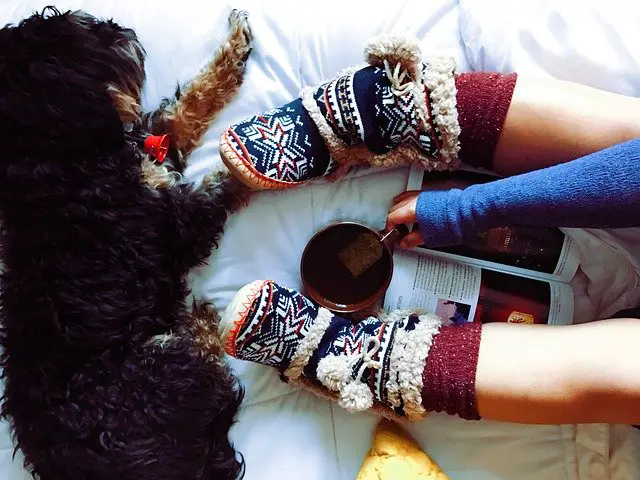If a pet parent is faced with the question: ‘what does it mean when a dog’s paws are cold?’ then it could be an indication that something is amiss.
Most dogs have fur or thick coats with which they regulate their body temperature. Therefore, cold paws are a rare occurrence in most domesticated, healthy dogs.
Continue reading to find out:
- 4 Tips to prevent your dog’s paws from getting cold
- 9 Surprising reasons why a dog’s paws get cold
- And a lot more…
What Does it Mean When a Dog’s Paws Are Cold?
When a dog’s paws are cold, it could indicate blood circulation issues. Blood flow problems in the paw pads due to a blood clot or heart ailment can cause cold paws. If there are no other symptoms your dog should be fine but if there are, then please call your vet.
9 Reasons What It Could Mean When A Dog’s Paws Are Cold?

#1. Blood Circulation Issue
In general, dogs are better adapted to cold climates than humans. They can stand, walk, and run on snow and ice for long periods of time. In contrast to the body trunk, which has dense fur, the paws are more exposed to the cold due to the lack of fur insulation. So how do they manage this?
In a 2011 article in Veterinary Dermatology titled “Functional anatomy of footpad vasculature in dogs: Scanning electron microscopy of vascular corrosion casts,” researchers looked at the mechanisms that keep dogs’ paws from freezing.
Researchers discovered that it was due to the ‘countercurrent heat exchange blood vessel system’ in the dogs’ paws which is similar to that found in the vented and webbed feet of penguins and seals.
This unique system of circulation helps dogs insulate their paws and withstand severe cold exposure.
However, in dogs with poor blood circulation, this ‘heat exchange’ system gets disturbed and that can result in cold paws and limbs.
Mostly, this occurs when the body is busy directing the blood flow elsewhere. And since the paws are situated far away from the dog’s core – where all the body heat is generated – the reduced blood flow – because it is directed elsewhere causes cold limbs.
Several factors can cause poor blood circulation in dogs:
- Blood loss or hemorrhage
- Hemolytic anemia
- Head trauma
- Seizures
- Excess vomiting/diarrhea
- Burns
- Drugs that cause blood thinning
- Heart ailments
- Bloat or buildup of pressure in the abdomen
- Septicemia due to internal injury/infection
Dogs with poor circulation show the following signs in addition to cold paws:
- Lethargy
- Extreme weakness
- Fainting spells
- Difficulty walking
- Cold ears and limbs
- Erratic breathing
- Weak pulse
If your dog has already been diagnosed with poor blood circulation, then your vet may have started medicines for it. Prognosis is usually good once the root cause of the poor circulation is established.
Also Read 5 Surprising Reasons Why Dogs Stick Out Their Tongues?
#2. Blood clot
Sometimes, blood clots and aneurysms can also cause poor blood flow and subsequent cold paws in dogs.
A blood clot – also called thrombosis – occurs due to a restricted artery or vein or when the lining of the blood vessel is damaged. Blood clots can form in blood vessels or the heart.
Many diseases can lead to blood clots in dogs. They include:
- Diabetes
- Kidney disease
- Cancer
- Heartworm disease
- Pneumonia
The signs and symptoms of blood clots in dogs are:
- Bloody mucus/cough
- Loss of control over bladder and bowels
- Breathing irregularities
- Head pressing
- Loss of coordination, eye, and facial reflexes
- Cold limbs, lameness, pain in the limbs.
Vets order MRI or CT-Scan to determine the location of the clot. Treatment includes medication to prevent clot formation – such as Streptokinase.
#3. Coming in from the cold

Sometimes, something as simple as coming in from the cold weather can also cause cold paws in dogs. Mostly, the temperature will return back to normal once your dog has rested in a warm place indoors.
In extreme cases, if a dog has been outdoors on an icy pavement or in a snow-filled yard for a prolonged period of time, then it could develop ice balls or frostbite from the extreme cold.
Ice-balls
Ice balls get formed in the paw pads between the toes and under the extra fur. These can lower the normal temperature of the dog’s paws causing pain and discomfort.
You can treat ice-balls at home with the following steps:
- Trim the excess fur from between the paw pads
- Soak your dog’s paws in warm (not hot) water.
- Very gently massage your pet’s paws
- Give it socks or booties to wear indoors and outdoors.
- Observe your pet. If it continues to show difficulty or pain while walking, seek advice from your vet.
Frostbite
If you walk your dog for a long time in cold weather, it could develop frostbite in the paws. The skin around the paw pads will appear pale and its ears and limbs will be cold to touch.
According to Dr. Tammy Hunter, DVM or VCA Hospitals, you should not ignore frostbite in dogs. It can get very serious quickly and could even cause necrosis in the affected tissues.
Dogs with frostbite will show the following signs and symptoms – typically in their paws/ears/or tail:
- Discoloration of the affected area of skin – pale, gray or bluish.
- Coldness and/or brittleness of the area when touched.
- Pain when you touch the body part(s).
- Swelling of the affected area(s).
- Blisters or skin ulcers.
- Areas of blackened or dead skin.
Dogs with poor circulation, diabetes, and other medical conditions are at a greater risk to frostbite.
How to tell your dog has frostbite
- Gently press on the paw pad and observe the color.
- In a normal dog, the paws will blanch first and then the color will be back to normal. This indicates that the blood flow is normal.
- In frostbite, the paws will appear pale, grayish, and cold to touch.
Treatment for frostbite includes:
- Slowly increasing body temperature with warm water bottles and blankets
- Washing affected parts with warm (NOT HOT) water. Ideal temperature for washing – around 104 F.
Please have your dog examined by the vet.
#4 Primary and secondary hypothermia
According to PetMD, hypothermia can also be a cause behind cold paws in dogs. Hypothermia usually occurs after prolonged exposure to cold air or water.
Normal dog’s body temperature is between 101 and 103.5 F. If it falls below 100, then hypothermia can set in.
Primary causes of hypothermia are: soaking in cold water, exposure to very cold temperature for prolonged periods, shock, or wet fur and skin.
Secondary hypothermia could be a result of diseases like kidney disease, hormonal imbalances and problems with blood flow. The symptoms of secondary hypothermia are not too severe.
Very young, old, skinny dogs, and dogs with kidney or thyroid conditions are also susceptible to hypothermia.
Avoid exposing your dog to very cold temperatures. In rescued dogs with hypothermia, it is best to warm the dog slowly with blankets, monitor its temperature every 10-15 minutes. If possible, use a heating pad to warm the dog – on the lowest setting. Seek medical help right away.
Find Out Surprising Answers to: Do Chihuahuas Get Cold Easy?
#5 The use of air conditioning indoors

According to the experts at Michelson Found Animals, many pet parents do not know how to set the indoor air conditioning or thermostat for their pets.
Different dog breeds have different tolerances for cold and heat. Some small dogs like Chihuahuas will immediately start shivering the moment the ambient temperature drops below 60.
Dogs with longer hair coats will naturally have more in the way of protection from the cold. Some health issues like diabetes, hormonal imbalances, and thyroid issues can also increase susceptibility to the cold.
Dogs have sweat glands on their paws and that is why these areas are the first to indicate whether your pet is too cold. Many also burrow or hide or lift their paws off the ground if they feel chilly.
If your dog is showing these signs, then there is a chance that it could be too cold from the air conditioner.
#6. Shedding and lack of fur
Most dogs usually do not have too much fur on their paws. Dog’s paws also have sweat glands and these areas on the dog’s body are the first to show signs of cold. They also sweat in summers – which is why you might see paw marks on floors in summers when the dog sweats.
Dog’s paws have a lot of adipose or fatty tissue but they can still get cracked from walking on cold or hot surfaces.
Some breeds like St. Bernards and Newfoundlands are known to have very large paws that are meant to walk in snow, ice, and tread cold water. Many breeds like Portuguese Water Dog, Chesapeake Bay retriever, and some pointers and spaniel breeds have webbing in between their paws to help them swim.
Irrespective of the breed, a dog’s paws have less hair and they tend to get colder than the rest of the body. This may be one of the reasons why your dog seeks warmth in winters and tries to jump on the bed or digs and burrows to seek warmth..
#7 Thyroid issue (Hypothyroidism)
According to PetMD, dogs with hypothyroidism tend to have very little tolerance to cold which is why their paws tend to become very cold quickly. The disease can occur in any dog but breeds like Golden Retrievers, Dachshunds, and Cocker Spaniels are more prone to it.
Symptoms of hypothyroidism include:
- Weight gain despite reduced appetite
- Black patches on skin
- Poor coat – dull and thin
- Cold paws and ears
- Sluggishness
- Toenail and ear infections.
A vet will diagnose hypothyroidism with a series of blood tests. Thankfully, the disease isn’t life threatening and can be managed with medicines and dietary changes.
#8. Older dogs

Older dogs often have reduced blood flow to the paws especially if they have a medical condition. This can include heart ailments, diabetes, kidney disease etc.
In general, senior dogs tend to sleep a lot and, sometimes, the excess sleeping tends to cut off blood supply to the paws. This is especially the case in winters.
Dogs with medical issues also have poor circulation which can redirect blood to parts that need it the most. This can sometimes cut off blood supply to the limbs. If your elderly dog isn’t showing any other signs of discomfort, then there is nothing to worry about if it only has cold feet.
However, if your dog has other signs and symptoms like bleeding, difficulty walking, pale gums, urinating indoors, shock, etc. then it is best to have a vet evaluate the root cause.
#9. Surgery
If a dog has had surgery recently, then anesthesia can cause decreased blood perfusion and subsequent reduction in blood flow to its limbs and ears. This can result in cold paws and hypothermia..
Vets counter this issue by providing the dog with plenty of Intravenous fluids to improve blood circulation. This should resolve the hypothermia or cold paws within a few hours after surgery.
Once home, as a precautionary measure, monitor your dog and take its rectal temperature. It should be between 100.2 and 103.8. If it is not within this range, and it has cold and numb paws, then please inform your vet.
4 Tips to Prevent Cold Paws in Dogs

#1. Use indoor heating in winters
Keep your dog comfortably warm in winters. Avoid exposing it to extreme cold weather. Use indoor heating and provide plenty of warm blankets and bedding. If you invest in an electric heating pad, it will be great. Your dog can sleep on the pad and warm its paws. Always monitor your pet when it is using the pad.
#2. Use socks
If your dog allows it, use socks or booties to keep its paws warm. These days, you get socks that help your dog grip the floor easily and not slip or skid.
The advantage of using pet socks is that they prevent their paws from getting dirty, wet, and cold in the grass, mud, rain and snow. In older dogs, they could help improve traction on tiles and slippery floors.
Make sure you keep your pet’s nails trimmed when it is wearing socks.
#3. Massage
Gently massage your dog’s paws (if your pet allows). This will improve blood flow and circulation. If needed, use some Vaseline on the paws to promote healing of cracked paws. You can also use a hot water bottle, warm compress, etc. to promote blood circulation to the paws.
#4. Treat underlying health issues
If your dog has cold paws with other symptoms like difficulty in walking, pain, defecating/urinating indoors, lethargy, bleeding, or other signs, please see your vet right away.


